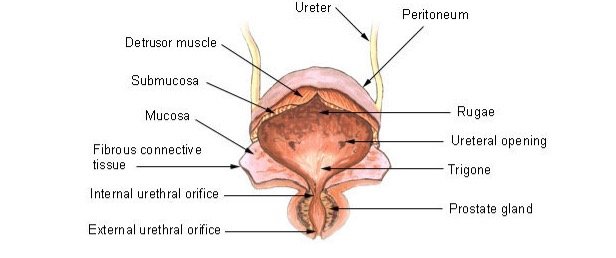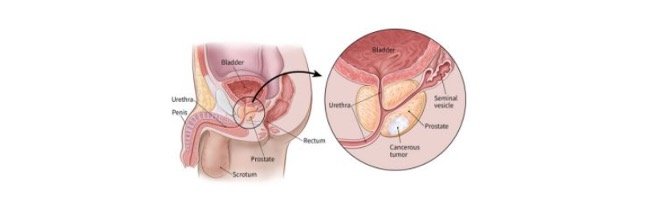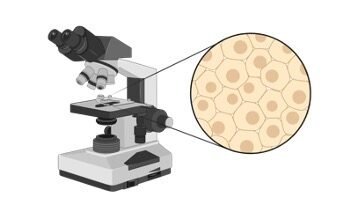Urinary Bladder Definition
An organ present in the urinary tracts of several animal species is called the urinary bladder. The urine is stored in the urinary bladder before urination. The urine is produced and delivered by the kidneys through two ureters. The urinary bladder in humans is capable to hold up to four cups of urine in its hollow, muscular structure.
Overview of Urinary Bladder
The structure of the bladder is composed of a broad fundus, body, apex, and neck. There are three openings in the human bladder, each of them is covered by a mucosal flap.
The flab prevents urine from flowing back into the ureters. The bladder differs its anatomical position between men and women.

Image Credit: https://training.seer.cancer.gov/
The urinary bladder in men is found in front of the rectum, whereas the position of the bladder in women is in front of the uterus. The bladder wall can stretch from 5 mm to 3 mm due to rugae or folds covering the inner walls.
The kidneys can continue filtering the blood due to the holding capacity of the bladder. When an organism cannot urine, the bladders store the urine. For example, during sleep, extra urine is stored in the bladder, which allows an organism to rest without urinating.
Urinary Bladder Function
The major function of the urinary bladder includes storing and collecting urine from the kidneys. They store urine, until its excretion via urination. An average of 300mL to 500mL of urine can be stored in a typical human bladder.
Due to the flattening of the rugae folds, the urinary bladder has high elasticity and can accommodate an increased volume of liquid. However, urination is not controlled by the bladder, but the pontine micturition center in the brain controls it.
Diseases of the Urinary Bladder
There are several diseases of the urinary bladder. Frequent urination, pain, irritation, and incomplete emptying are some common symptoms of bladder diseases. Occasionally, the urinary bladder can be affected by diseases of other tissues or organs.
For example, frequent urination can be caused by an enlarged prostate. Some most common pathologies of the urinary bladder are as follows:
1. Bladder Cancer
Bladder cancer occurs commonly in the epithelial lining of the bladder. Approximately 90% of all bladder cancers are carcinomas. The common causes of bladder cancer include infection, cigarette smoke exposure, and medications.
2. Urinary Tract Infection
A major public health concern can be posed by urinary tract infections, which can be severe. Some bacterial infections in the bladder are the major cause of these infections. The bacteria traveling up the urethra and into the bladder may cause infections.
UTIs can be very dangerous when left untreated because the infection can increase and infect the bladder and kidneys.
Burning sensation during urination, frequent urge to urinate, despite little urine being released, foul-smelling urine are some common symptoms of UTIs.
3. Bladder Stones
Hard deposits found in the bladder are called bladder stones. The stones are composed of minerals and caused by highly concentrated urine resides in the bladder, dehydration.
The size of the stone can vary and typically it is asymptomatic. Pain, blood in the urine, and irritation are the common symptoms of bladder stones. Typically, the bladder stone can be identified by using ultrasound, X-rays, and CT scans.
4. Neurogenic Bladder
It is a type of brain disorder, due to which, an organism’s ability of urination impacts. Urination is typically aided with a catheter because the peripheral nerves involved in urination are affected. Patients suffering from neurogenic disorder use intermittent catheterization to empty their bladder several times a day.
5. Bladder Exstrophy
Bladder exstrophy is a congenital abnormality. It involves the protrusion of the bladder, which is a rare condition. Generally, the condition arises due to abnormal development of the pelvic floor and other muscles. In women, it causes the development of genitals.
6. Bladder Sphincter Dyssynergia
The condition in which the urethral sphincter cannot be relaxed in coordination with bladder contraction is referred to as bladder sphincter dyssynergia. The common causes for this disease include injury or disorder in the central nervous system. In this disorder, patients have a history of bladder infections and they also frequently feel urine retention.
7. Paruresis
A phobia in which a person cannot urinate due to the presence or perceived presence of others is called paruresis. A sympathetic nervous system response causes this disease by tightening the sphincters in the bladder in response to adrenaline and finally preventing urination. Psychological therapy is required to treat this disease.
8. Trigonitis
The condition that involves inflammation of the trigone region of the bladder is called trigonitis. In response to stretching, the trigone, which is a smooth triangular-shaped region, signals the need for urination. When the region is inflamed, it causes an urgent need for urination, pain in the pelvic region, and pain during urinating. The most common cause of trigonitis is bladder infections, but it can be caused due to several causes.
9. Interstitial Cystitis
Chronic bladder pain is defined as a condition of interstitial cystitis. However, damage in the epithelial lining of the bladder is seen in patients, but the specific causes of interstitial cystitis are unknown. The symptoms include an urgent need to urinate, pain, and frequent urination. Typically, a negative urine culture is used for diagnosis because the symptoms are highly similar to urinary tract infection.
10. Urinary Retention
A condition in which an individual becomes unable to completely empty the bladder is called urinary retention. Poor pressure when urinating, straining to urinate, the sensation of a full bladder are some common symptoms of this disease. If the disease cannot be treated, it causes a ruptured bladder, thus it is considered to be an emergency. The cause is several and it can be treated by catheterization, surgery is required in some cases.
Urinary Bladder Citations
Urinary Bladder: https://training.seer.cancer.gov/anatomy/urinary/components/bladder.html
Picture of the Bladder: https://www.webmd.com/urinary-incontinence-oab/picture-of-the-bladder
Share












